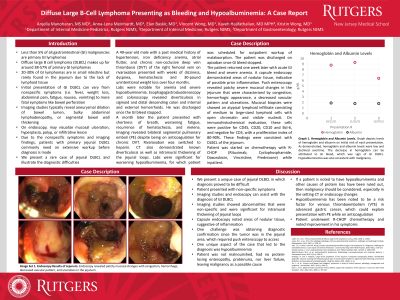Back


Poster Session C - Monday Afternoon
Category: Small Intestine
C0662 - Diffuse Large B Cell Lymphoma Presenting as Bleeding and Hypoalbuminemia: A Case Report
Monday, October 24, 2022
3:00 PM – 5:00 PM ET
Location: Crown Ballroom

Has Audio

Anjella Manoharan, MS, MD
Rutgers New Jersey Medical School
Newark, NJ
Presenting Author(s)
Anjella Manoharan, MS, MD, Anna-Lena Meinhardt, MD, Elan Baskir, MD, Vincent Wong, MD, Kaveh Hajifathalian, MD, MPH, Kristin Wong, MD
Rutgers New Jersey Medical School, Newark, NJ
Introduction: Diffuse large B cell lymphoma (DLBCL) accounts for 38-57% of primary gastrointestinal (GI) lymphomas. Initial presentation can include nonspecific symptoms, such as weight loss, fatigue, and nausea. Imaging studies are typically nonspecific as well. Therefore, patients are commonly misdiagnosed or diagnosis is delayed. 20-30% of GI lymphomas are in the small intestine but are rarely in the jejunum. We present a rare case of jejunal DLBCL and illustrate the diagnostic difficulties.
Case Description/Methods: A 49-year-old male presented with weeks of dizziness, dyspnea, hematochezia, and 30-pound unintentional weight loss over 4 months. Labs were notable for anemia and severe hypoalbuminemia (1.9 g/dL). Esophagogastroduodenoscopy and colonoscopy revealed diverticulosis and hemorrhoids, which were the presumed etiology of his symptoms. One month later, the patient presented similarly. Imaging demonstrated bilateral pulmonary emboli and intramural thickening of the jejunum. For worsening hypoalbuminemia (1.3 g/dL), the patient was scheduled for outpatient work-up. However, he presented again for acute GI bleed and severe anemia. Push enteroscopy revealed patchy mucosal changes in the jejunum and biopsies were consistent with DLBCL. The patient was started on chemotherapy and reported improvement in symptoms and resolution of his GI bleed.
Discussion: Primary GI DLBCL is rarely found in the jejunum due to the lack of lymphoid tissue, making this case noteworthy. GI DLBCL is difficult to diagnose, since patients may be asymptomatic or present with nonspecific symptoms. Small intestinal DLBCL can present with GI bleeding, which can easily lead to a misdiagnosis of a diverticular or hemorrhoidal bleed. Imaging studies can be nonspecific and obtaining confirmation through biopsy can prove difficult due to its location, further complicating the diagnosis. One unique aspect of this case that led to the diagnosis was the severity of hypoalbuminemia. The patient was not malnourished, had no clinically apparent protein-losing enteropathy, and no proteinuria or liver failure, making underlying malignancy likely. Differential diagnoses of small bowel wall thickening on imaging is wide and includes infections, primary inflammatory processes such as IBD, and neoplastic lesions. DLBCL may have unusual clinical presentations, subtle laboratory findings and may not be easily diagnosed with initial imaging; thus, clinicians should remain vigilant of this possible diagnosis.
Disclosures:
Anjella Manoharan, MS, MD, Anna-Lena Meinhardt, MD, Elan Baskir, MD, Vincent Wong, MD, Kaveh Hajifathalian, MD, MPH, Kristin Wong, MD. C0662 - Diffuse Large B Cell Lymphoma Presenting as Bleeding and Hypoalbuminemia: A Case Report, ACG 2022 Annual Scientific Meeting Abstracts. Charlotte, NC: American College of Gastroenterology.
Rutgers New Jersey Medical School, Newark, NJ
Introduction: Diffuse large B cell lymphoma (DLBCL) accounts for 38-57% of primary gastrointestinal (GI) lymphomas. Initial presentation can include nonspecific symptoms, such as weight loss, fatigue, and nausea. Imaging studies are typically nonspecific as well. Therefore, patients are commonly misdiagnosed or diagnosis is delayed. 20-30% of GI lymphomas are in the small intestine but are rarely in the jejunum. We present a rare case of jejunal DLBCL and illustrate the diagnostic difficulties.
Case Description/Methods: A 49-year-old male presented with weeks of dizziness, dyspnea, hematochezia, and 30-pound unintentional weight loss over 4 months. Labs were notable for anemia and severe hypoalbuminemia (1.9 g/dL). Esophagogastroduodenoscopy and colonoscopy revealed diverticulosis and hemorrhoids, which were the presumed etiology of his symptoms. One month later, the patient presented similarly. Imaging demonstrated bilateral pulmonary emboli and intramural thickening of the jejunum. For worsening hypoalbuminemia (1.3 g/dL), the patient was scheduled for outpatient work-up. However, he presented again for acute GI bleed and severe anemia. Push enteroscopy revealed patchy mucosal changes in the jejunum and biopsies were consistent with DLBCL. The patient was started on chemotherapy and reported improvement in symptoms and resolution of his GI bleed.
Discussion: Primary GI DLBCL is rarely found in the jejunum due to the lack of lymphoid tissue, making this case noteworthy. GI DLBCL is difficult to diagnose, since patients may be asymptomatic or present with nonspecific symptoms. Small intestinal DLBCL can present with GI bleeding, which can easily lead to a misdiagnosis of a diverticular or hemorrhoidal bleed. Imaging studies can be nonspecific and obtaining confirmation through biopsy can prove difficult due to its location, further complicating the diagnosis. One unique aspect of this case that led to the diagnosis was the severity of hypoalbuminemia. The patient was not malnourished, had no clinically apparent protein-losing enteropathy, and no proteinuria or liver failure, making underlying malignancy likely. Differential diagnoses of small bowel wall thickening on imaging is wide and includes infections, primary inflammatory processes such as IBD, and neoplastic lesions. DLBCL may have unusual clinical presentations, subtle laboratory findings and may not be easily diagnosed with initial imaging; thus, clinicians should remain vigilant of this possible diagnosis.
Disclosures:
Anjella Manoharan indicated no relevant financial relationships.
Anna-Lena Meinhardt indicated no relevant financial relationships.
Elan Baskir indicated no relevant financial relationships.
Vincent Wong indicated no relevant financial relationships.
Kaveh Hajifathalian indicated no relevant financial relationships.
Kristin Wong indicated no relevant financial relationships.
Anjella Manoharan, MS, MD, Anna-Lena Meinhardt, MD, Elan Baskir, MD, Vincent Wong, MD, Kaveh Hajifathalian, MD, MPH, Kristin Wong, MD. C0662 - Diffuse Large B Cell Lymphoma Presenting as Bleeding and Hypoalbuminemia: A Case Report, ACG 2022 Annual Scientific Meeting Abstracts. Charlotte, NC: American College of Gastroenterology.
